LESSON TWO - GOAL SETTING
INTRODUCTION:
Integrated resource management involves setting realistic goals. First, make a wish list of what you would like from your land. Second, get to know the resources available to you, from your woodlot and yourself (eg. time, expertise, help from others). Third, set priorities.
While working on your goals consider the following three basic principles:
- A woodlot is not self-contained. It is part of the larger landscape and your actions affect land elsewhere, often in ways you may not understand.
- Your property includes smaller parts that influence and sustain the larger property (eg. Seeps or bogs purify water, or stone piles, snags, or downed trees may provide special habitat that does not occur else where on the property). You should consider all parts of your woodlot.
- Today's decisions define, limit, or expand future opportunities.
Now is the time to make a wish list. Include things you are already doing (from your list on page 3). What do you want to do with your land? What are your goals and objectives for the property? What are your guiding principles? The list does not have to be realistic at this stage. You will have time to make it realistic when you develop priorities.
Keeping the basic principles in mind, some potential goals might be to:
- improve woodlot for personal recreation
- make an annual income from the woodlot
- improve tree quality and value
- increase wildlife habitat quality
- make the woodlot accessible for community use
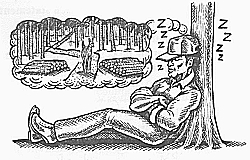 |
| Illustration 2. It helps to think about your woodlot objectives when you are relaxing in your woodlot. |
Some specific objectives to meet the above goals might be to:
- build a pond for fire protection, skating, and wildlife (Goals 1 and 4).
- cut and sell 15 cords of firewood per year (Goals 2 and 3).
- start a small nursery to help restock the woodlot with hardwood and shrubs to benefit wildlife (Goal 4) or to improve the genetic stock of what is already there (Goal 3).
- connect wood extraction trail to public road (Goals 1, 2, and 5).
Exercise 2: Now list your goals and objectives below. You may wish to consider the goals of other family members and friends at this time or add them later.
| Goal | (fill in later) |
| Objective | |
Some landowners may want to group their goals according to specific resource benefits such as timber, wildlife, aesthetics, or recreation.
RESOURCES
A key to practicing IRM effectively is getting to know your woodlot and working with what you have. It is important to know both your own and your land's limitations, if only to realize that you have to find other ways to get things done.
Some woodlots offer scenic locations for campsites or cabins; others provide a large quantity of timber; and others offer great wildlife habitat. Some people have lots of time, equipment, and expertise to work with their woodlot while others are limited. Table 2 lists resources to consider as you establish priorities for your goals.
Before walking through your woodlot, obtain some recent aerial photos to locate open water, non-forested areas, wetlands, and softwood and hardwood cover types. Then determine what needs or opportunities there are for your property and possibly for surrounding properties. Consider the following:
- What do the surroundings provide for you? What do you enjoy about them?
- Do you have a stream, spring, pond, or lake?
- Where do you hear or see birds?
- Are there nuts or berries on your woodlot?
- Do you like bright or shady areas?
- What important benefits can your land provide?
Table 2: Potential woodlot and personal resources.
| wildlife habitat quality and quantity | free time |
| streams, lakes, and ponds | family's, friend's, neighbors' time |
| regeneration quality | financial resources |
| surrounding woodlots (potential for cooperation) | expertise |
| local markets for various products (location of woodlot) | availability of hired help (eg. someone to cruise your lot) |
| future opportunities - u-cut Christmas trees - u-fish |
house, camp, or place to stay |
| access roads and trails | equipment |
| timber quality and quantity | |
| marsh or wetlands | |
| beaches | |
| road construction materials (gravel, shale, etc.) |
|
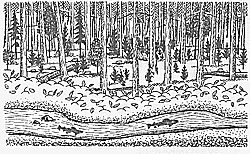 |
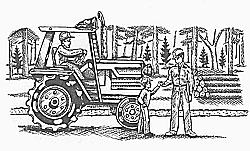 |
| Illustration 3. Each woodlot contains its own unique combination of resources and values. | Illustration 4. Family and equipment can make woodlot work much easier. |
Exercise 3: List your personal and woodlot resources. You will come back to this later.
If your resources are limited, try to find ways to make them go further. You may consider hiring someone to haul or cut wood, setting up an operation that allows customers to help themselves (eg. u-cut Christmas trees), or getting help from the community to build hiking trails.
| Did you know that thinning can improve future wood quality and aesthetics? By cutting small, poor quality trees, the woods look better and allow better visibility between the trees. Leaving large trees will improve the appeal of a woodlot and add to structural diversity. For more information on thinning see Home Study Module 3. |
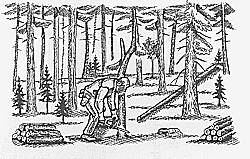 |
| Illustration 3. Harvesting poor quality trees for firewood can result in more valuable trees left on the woodlot in the future. |
SET PRIORITIES
Now that you have brain stormed about what you might be able to do with your woodlot and looked at your resources, it is time to make the list more realistic.
Exercise 4: Talk to adjoining landowners to see what their plans are. Are there any opportunities to cooperate? This may also be an opportunity to check your boundary lines.
Opportunities for cooperation
eg. wildlife travel corridors, trails or roads.
To establish priorities, look for complementary and conflicting goals and objectives. Complementary goals are those that can be achieved at the same time in the same place (see Table 3 for examples), usually by doing one activity. Look back to page 4 for examples where one activity accomplishes more than one goal. The more goals an activity fulfills the more worthwhile the activity becomes.
Table 3: Examples of complementary and conflicting goals (adapted from the Forest Stewardship Planning Guide).
C - compatible or complementary to each other, E - effort required to do both, T - two separate areas required
| Increase wood value | C |
||||||
| Increase early successional habitat | E |
C |
|||||
| Maintain or enhance water quality | C |
C or E |
C |
||||
| Maintain an over story canopy | C |
E |
C |
C |
|||
| Minimize damage by insects and disease | C |
C or E |
C |
C |
C |
||
| Produce and sell gravel | T |
E or C |
E |
T |
C |
C |
|
| Promote old forest conditions | E |
T |
C |
C |
T |
T |
C |
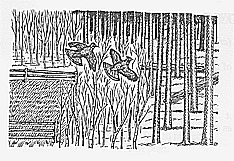 |
| Illustration 6. Managing for quality ruffed grouse habitat might be difficult if you want to grow softwood logs. However, it is possible to manage for grouse in one area of your lot and saw logs in another. |
Conflicting goals require separate areas or considerable effort to achieve (see Table 3). For example, income from clearcutting a young stand will reduce the potential for income from logs in that same stand in 10 years time. Or a gravel pit may create an area that is less pleasant to look at for a while.
If time is considered, conflicting goals may become more compatible. An area that is clearcut may regenerate and produce logs in 50 years or a gravel pit might be rehabilitated and produce logs in 100 years. Time is more likely to be considered by landowners who do not need to meet several goals from a small area in a short period.
Some goals that appear to be conflicting may not be. For example, harvesting may appear to damage wildlife habitat or recreation potential. However, if forest/wildlife regulations are followed, habitat quality can often be maintained or even improved for some species. If aesthetics are considered and extraction trails kept clear of debris, recreational opportunities could be improved (for more information on this, see Home Study Module 9).
Consider the resources you have to work with, complementary and conflicting goals, and neighboring properties; then go back to the list you developed on page 4 and prioritized the list by placing a number beside each activity. You may want to redo your list at the back of the book (see page 25) and put the higher priority items near the top while eliminating goals that are not realistic.